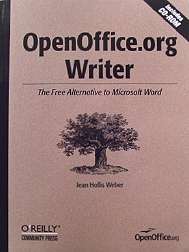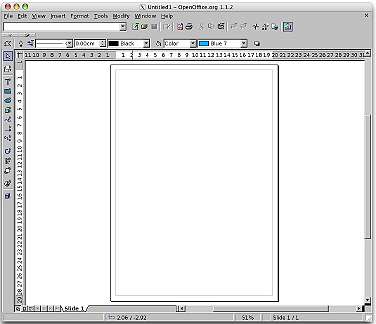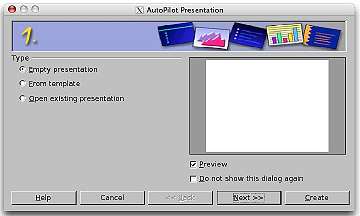 Mac-formatted disks cannot be read by a PC, although PC-formatted disks
can be read by Macs. As for the files themselves, a doc file is a doc
file, as xls is xls and, when used, vcards (vcf) are vcards. Standards
are standards.
Mac-formatted disks cannot be read by a PC, although PC-formatted disks
can be read by Macs. As for the files themselves, a doc file is a doc
file, as xls is xls and, when used, vcards (vcf) are vcards. Standards
are standards.
eXtensions
|
Using Open Office: Updated version, and a Book to Ease the Way |
Weber, Jean Hollis. OpenOffice.org Writer: The Free Alternative to
Microsoft Word. O'Reilly; Sebastopol, CA. US$24.95. ISBN
0-596-00826-0
A constantly repeated myth about Macs is that there is no software. With in excess of 12,000 applications for OSX, this should be interred. Another error that prevents people moving to OSX comes from the slavish devotion to Microsoft Office (there is an OSX version), coupled with the idea that PC files cannot be used on Macs and vice versa.
 Mac-formatted disks cannot be read by a PC, although PC-formatted disks
can be read by Macs. As for the files themselves, a doc file is a doc
file, as xls is xls and, when used, vcards (vcf) are vcards. Standards
are standards.
Mac-formatted disks cannot be read by a PC, although PC-formatted disks
can be read by Macs. As for the files themselves, a doc file is a doc
file, as xls is xls and, when used, vcards (vcf) are vcards. Standards
are standards.
I have used several examples of shareware or freeware: as experiments; and when Apple's pre-installed applications are not enough. I use TextEdit to create rich text files which I can save as documents -- including images and more. All many users need to do is write a memo or a brief letter. On occasion, I want something with more beef, particularly with the Excel file-type (remember Excel was first created for Macs before becoming a component of Office).
My alternatives for the Office suite have included OpenOSX Office, ThinkFree Office and Open Office. I first had a look at Open Office in April last year. It has recently been released as version 1.1.2 for OSX.
I was sent Jean Weber's book shortly after downloading it from the Open Office site. Weber explains the inner workings of the Writer. Although she concentrates on version 1.1.1, changes have only been minor bug-fixes, so Weber is up to date.
Also included in OpenOffice are spreadsheet, presentation and drawing programs, as well as an HTML authoring tool: an alternative to those that tie one in to a specific browser. There are also scores of graphics and insertable sounds.
File transfers between programs may cause some slight compatibility problems. I have found OpenOffice better when creating documents (or xls files) than when opening files created in other applications or on other platforms. This was particularly so when using Thai fonts.
When working in OpenOffice -- documentation claims this is a "work in progress" -- I made copies of any file I used, particularly those created in Microsoft Word on XP. Although this format can be opened (and documents saved), the Thai fonts were not at their best unless saved in the Open Office format (sxw).
X11 windows must be installed (on disk three of a Panther installation) before this suite can be used. Installation is as smooth as native OSX applications and was running within a few minutes. The "Start OpenOffice" utility included is much improved. I had tried this a few months ago with OpenOffice for OSX developed at NECTEC and I could not make that particular utility work: it would be good to see NECTEC come up with a version that handled Thai well. (Note: It would also behove NECTEC to come up with a better-organised website.)
Speed is much improved. Clicking on the icon starts X11 and then the Office suite. On my eMac 1.25 with 1GB of memory, X11 took 6 seconds to open and Office another 4 seconds. One more click allows you to open a file. Everything is open in less than 15 seconds. This time can be reduced to zero if the application is left open and X11 hidden: no memory is used by inactive programs.
Jean Weber's book greatly increased my knowledge of how to use Writer and how to set up OpenOffice itself. One thing I did not like about the suite was the distinctly Microsoft feel to the whole thing, particularly the directory structure and the Configuration. Using Weber's book allowed me to examine these step by step.

|

|
As I went through the pages, I found that it helped me to appreciate even more the work that had gone into OpenOffice: it is a strong tool and (despite some minor file problems) has muscle. An example of the detail in the Weber book is in the section that outlines working with footnotes, something that I know has delayed migration of some from the Microsoft product.

|

|
Each component of Office allows saving in several formats including Microsoft, Star Office and Open Office. The drawing program only uses Star and OpenOffice formats.
Weber has produced a book that is packed with information. She was correct to stick to Writer than to try and write a book that covers the whole of the office suite. There is a CDROM included and this contains Open Office for Windows, Linux, Solaris and OSX.
Open Office has come a long way and is certainly usable for day to day work. Jean Weber's book complements the development of this open source software and would be of great value to anyone wanting to migrate to this suite.

For further information, e-mail to Graham K. Rogers.
Back to
eXtensions
To
eXtensions: Book Reviews
To
eXtensions: Year One
Back to homepage